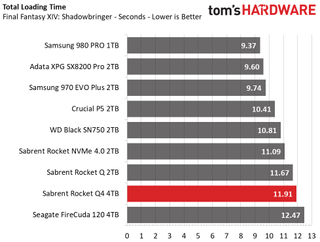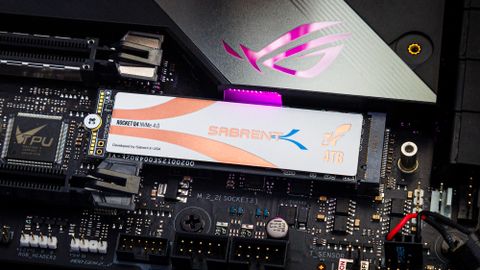Why you can trust Tom's Hardware
Comparison Products
Today, we put the Rocket Q4 up against a few of the best SSDs on the market, as well as the company’s Rocket Q and Rocket NVMe 4.0. We also included a Samsung 980 Pro and 970 EVO Plus along with Adata’s XPG SX8200 Pro. Additionally, we added Crucial’s P5, a WD Black SN750, and a SATA-based Seagate FireCuda 120 for good measure.
Game Scene Loading - Final Fantasy XIV
Final Fantasy XIV’s Shadowbringer is a free real-world game benchmark that easily and accurately compares game load times without the inaccuracy of using a stopwatch.

Samsung’s 980 PRO remains the fastest performer, but Sabrent’s Rocket Q4 was far from it in this particular benchmark. While it outperformed the Seagate FireCuda 120, it lagged most high-end SSDs by a second or two and was even outpaced by both the lower capacity Sabrent Rocket NVMe 4.0 and Rocket Q.
Transfer Rates – DiskBench
We use the DiskBench storage benchmarking tool to test file transfer performance with our own custom block of data. Our 50GB data set includes 31,227 files of various types, like pictures, PDFs, and videos. Our 100GB test consists of 22,579 files, with 50GB of them being big movies. We copy the data sets to new folders and then follow-up with a reading test of a newly written 6.5GB zip file and 15GB movie file.




Sabrent’s Rocket Q4 handles large file transfers with satisfying speed, and it notched a very high ranking even when we hit it with a massive 100GB file copy. It fell second to only the Samsung 980 PRO when we read back the files, even outperforming the Sabrent Rocket NVMe 4.0’s responsiveness with dual-plane TLC flash.
Trace Testing – PCMark 10 Storage Tests
PCMark 10 is a trace-based benchmark that uses a wide-ranging set of real-world traces from popular applications and everyday tasks to measure the performance of storage devices. The quick benchmark is more relatable to those who use their PCs for leisure or basic office work, while the full benchmark relates more to power users.






The Rocket Q4’s high-end NVMe controller performed well when we tested the drive with the Quick System Drive benchmark, attaining a third-place ranking. However, the Sabrent Rocket Q4’s PCMark 10 results showed that it couldn’t keep pace with the high-end Gen3 competitors, like Crucial’s P5 or Samsung’s 970 EVO Plus, when we tested the Full System Drive benchmark – the Samsung 980 PRO delivered literally twice the performance.
Trace Testing – SPECworkstation 3
Like PCMark 10, SPECworkstation 3 is a trace-based benchmark, but it is designed to push the system harder by measuring workstation performance in professional applications.



Again, the Samsung 980 PRO is in a league of its own, but the Rocket Q4 doesn’t do too badly. Scoring fifth place overall and completing the workloads in the third-fastest time, the Sabrent proves that it can handle quite a bit of abuse and keep delivering responsive performance, too.
Synthetic Testing - ATTO / iometer
iometer is an advanced and highly configurable storage benchmarking tool, while ATTO is a simple and free application that SSD vendors commonly use to assign sequential performance specifications to their products. Both of these tools give us insight into how the device handles different file sizes.










We tested Sabrent’s Rocket Q4 at a queue depth (QD) of 1, representing most day-to-day file access at various block sizes. The Rocket Q4 offers up very competitive performance and even matches the Rocket NVMe 4.0 in sequential read performance. After bumping up the QD a bit, the Rocket Q4 peaked at roughly 5/3.6 GBps read/write.
The Rocket Q4 responds very quickly during random workloads at low queue depths, scoring a third-place ranking at QD1. When taxed with heavier workloads, the drive scored top marks in random write performance but only delivered a bit over 213,000 random write IOPS.
Sustained Write Performance and Cache Recovery
Official write specifications are only part of the performance picture. Most SSDs have a write cache, a fast area of (usually) pseudo-SLC programmed flash that absorbs incoming data. Sustained write speeds can suffer tremendously once the workload spills outside of the cache and into the "native" TLC or QLC flash. We use iometer to hammer the SSD with sequential writes for 15 minutes to measure both the size of the write cache and performance after the cache is saturated. We also monitor cache recovery via multiple idle rounds.





Sabrent’s Rocket Q4 delivers consistent write performance both in and outside of its SLC cache. The SLC cache absorbs 1TB of data before write performance degrades from an average rate of 3.6 GBps down to 200 MBps (once filled). With such fast write performance out of the gate, the Q4 surpasses most SSDs until the cache fills, but it is a bit disappointing if your workload exceeds it.
The cache isn’t as fast to recover as the company’s Rocket NVMe 4.0, as QLC NAND flash takes a lot longer to program. However, it will recover fairly predictably. The cache recovered partially after a few minutes of idle time, but the performance was still in a degraded state. Write speed improved to 500-700MBps. Performance recovered fully after half an hour of idle time, during which the drive reclaimed roughly 390GB of the cache capacity.
Power Consumption and Temperature
We use the Quarch HD Programmable Power Module to gain a deeper understanding of power characteristics. Idle power consumption is an important aspect to consider, especially if you're looking for a laptop upgrade. Some SSDs can consume watts of power at idle while better-suited ones sip just milliwatts. Average workload power consumption and max consumption are two other aspects of power consumption, but performance-per-watt is more important. A drive might consume more power during any given workload, but accomplishing a task faster allows the drive to drop into an idle state faster, ultimately saving power.
We also monitor the drive's temperature via the S.M.A.R.T. data and an IR thermometer to see when (or if) thermal throttling kicks in and how it impacts performance. Bear in mind that results will vary based on the workload and ambient air temperature.





With a bigger thirst for power than its Gen3 counterpart, the Rocket Q4 scores similarly in its efficiency as the Rocket NVMe 4.0. It also consumed a high amount of power at idle when ASPM is disabled. The drive consumed under 75mW with ASPM enabled, which is much less than the WD Black SN750.
When it comes to its heat output and thermal throttling, there isn’t much need for concern. Idle temps were a little warm around 50-53C, and under load, the controller peaked at 83 degrees Celsius after sustaining a solid 400GB of writes with no airflow in a 24 degree-Celsius room. Under most typical consumer use, the copper heat spreader provides ample cooling, even when the drive is under full load.
MORE: Best SSDs
MORE: How We Test HDDs And SSDs
MORE: All SSD Content

Sean is a Contributing Editor at Tom’s Hardware US, covering storage hardware.
-
atomicWAR Picked up one of the 2TB varients. It's a great game drive...super fast game loads. I use my HDD Pool for bulk game storage then transfer games to the Sabrent Rocket Q4 for actual gameplay. Seriously can't complain so far. I do worry about endurance being QLC but for now things are awesome!Reply
